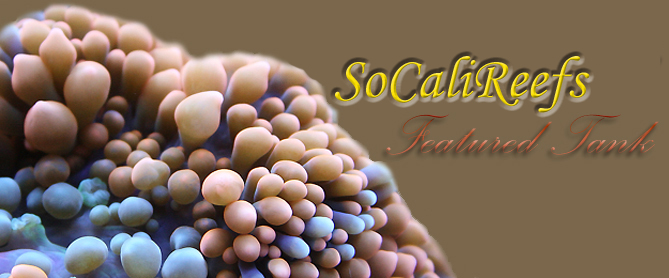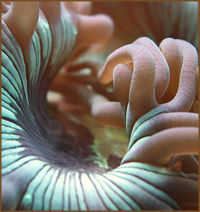
member: MINH HUYNH/GoTakuF1 of sd, CA
My journey into keeping aquariums started when I was a wee boy when my dear father took me to a local pet shop…wait a minute, do you really care? Right, let’s get on with it! Affectionately known as the “Big Tank,” the 130g is an experimental setup to prove, mostly to myself, that it is possible to accomplish more with less. It is a very Spartan set up mainly to focus on the corals of the genus Goniopora and a few others like Catalaphyllia Jardinei and Gorgonians. The “Little Tank” is a 24g NanoCube that uses the same principles as the “Big Tank”. The majority of the corals in these two tanks were given to me as frags by the good folks on SDReefs. In the case of the gonioporas, I obtained most of the specimens as “close to dead” or “dying” from LFS or other hobbyists. The primary goal is to rehabilitate these corals and establish some captive-bred strains for the local hobbyists in San Diego.
The “Big Tank” is a 130 gallon glass tank with Euro-bracing measuring in at
48”Lx26”Wx24”H. It is rather old, 8 years to be exact, and has the scratches to show.
The “Little Tank” is a standard 24 gallon NanoCube.
Efficiency was the goal for lighting both the “Big Tank” and “Little Tank.” The latter was an easy selection as the dimensions of the NanoCube limits the viable choice to a 150W metal halide setup. The 150W Giesemann Nova II was chosen for its compact size and sleek design. Unfortunately, the Iwasaki 50k lamp was not available at the time of set up so I went with the next best option, Phoenix 14k. An Ikea lamp post was retrofitted to suspend the Nova II pendant 14” from the tank. The desired inhabitants of the “Big Tank” would need something both relatively high in PAR (photosynthetic available radiation) and PUR (photosynthetic usable radiation) so a combination of 2x175W Iwasaki 15k and 2x95W Super Actinic VHO was selected. To extract the most performance out of the Iwasaki 15k, a pair of Icecap ballasts coupled with a LumenArc3/LumenMax combo. All the metal halides are on a 6 hour run daily while the VHOs burn 2 hours longer. The top of the 12” tall canopy for the tank is completely open. Since the lighting setups for both tanks are well vented and run very efficiently, additional cooling is not needed. Also very little equipment is used in-tank and as a result, a chiller and/or fans are not needed to maintain temperature. There are two 250W Ebo Jager heaters set to 75 degrees on the “Big Tank.” Depending on ambient temperature, the tank temperature swings up to 78-79 degrees at the end of the lighting cycle and drops back to 75 degrees at night. This is the same scheme on the “Little Tank” but is accomplished with a 100W Ebo Jager heater. No temperature controller is employed and these temperature swings are deliberate.
Flow is perhaps the most difficult part of a reef system to design and tune. First, one has to take into account the flow requirement of a system’s intended inhabitants. Second, one has to figure out the most appropriate aquascaping scheme to allow for the best flow pattern. And lastly, the most difficult part comes in finding the right combination of equipment to accomplish these goals. For the “Big Tank,” I decided to go with a very open, low and sparse aquascape design and took care in leaving a 5” perimeter around the tank unobstructed. This design, with the aide of four Maxi-Jet 600 (160gph/7.5W) powerheads on a Tsunami Wavemaker on 45 second alternation can create a gyre reaching around the entire tank. In addition to these four MJ600 powerheads, only a MJ900 is used to feed the behind-tank refugium. In a similar design in the “Little Tank,” a MJ400 is modified to alternate at a 45 degree angle via a Red Sea Wavemaster Pro. An island aquascape that allows a 3” unobstructed perimeter allows the MJ400’s flow to reach around the entire tank. Additionally a MJ600 is used as a main circulation pump.
With the intended livestock for the “Big Tank” being rather atypical, some unusual means of filtration had to be implemented. So, kiss that skimmer good buy. Sump, what sump? How about a deep sand bed? Well, there’s no sand at all. Wait a minute; I got to have a fluidized reactor to run phosphate removing media at least? Nope, none! What I do have is a 30 gallon low-flow and gravity returned refugium and a tiny bag of granulated activated carbon. Aside from the 50lbs of live rock in the display and 20lbs of live rock in the refugium, that’s all for filtration for 130 gallons of saltwater. Why did I do this, you ask? Well, this method requires the least amount of effort on my part to maintain as I can be quite lazy. So that means no skimmer to tune or clean. But, more importantly, this filtration method’s primary focus is on micro fauna. Yes, lots and lots of micro fauna. When the tank was initially set up, it was allowed to run for close to 6 months with a few corals and no fish. Without any intervention from me, there was an explosion of life in the tank and especially the refugium. Sponges, aiptasia (great filter feeder), tunicates, worms, dusters, micro crustaceans and countless other “who knows” are teaming in the refugium. There’s also a 1” thick layer of detritus on the bottom of the refugium that I’m convinced is not hurting the tank but could be beneficial. The only intervention on my part is changing out 4 tablespoons of Black Diamond carbon and changing 20 gallons of Reef Crystals mixed water every week. Note: I try to use Scripps natural salt water as much as possible i.e. when I have time to drive 20 miles! The “Little Tank” is very similar in terms of the simplistic filtration philosophy. About 20 lbs of live rock is used in the tank and a few pieces of rubble in the first stage of the NanoCube faux sump chamber. There is a PAR38 lamp that is fitted behind the tank to light the macro algae-filled second chamber. A 5 gallon water change is all that’s needed weekly from me.
Maintenance:
Water Parameters: Water Parameters for both tanks:
Specific Gravity – 1.025 – 1.027
Temperature – 75-79 degrees
pH - ?
Ammonia - ?
Nitrite - ?
Nitrate - ?
Calcium - ?
Alkalinity - ?
Magnesium - ?
Unfortunately, I can’t tell you the test readings that have a “?” next to them because, well, I don’t know. I don’t test for anything other than salinity and make sure my heaters aren’t broken by glancing at the cheap Coralife thermometer. The best test for water chemistry has always been the observation my corals and fish. Now, what do I do about water quality? Well, my motto has always been “The solution to pollution is dilution.” So, I just do water changes, very consistently. That’s all, really. As for supplementation, I have two Litermeter dosing pumps that replenish evaporated water with limewater on both tanks. On the “Big Tank,” I have a 15 gallon bin hidden away that has kalkwasser mixed from RO/DI water (produced by Spectrapure’s MAXCAP) and Mrs. Wages pickling lime. On the “Little Tank,” it is the same scheme but done with a 5 gallon bin. I mix a new batch of kalkwasser every three weeks. Aside from that, I dose 5 ml of “Kent Marine Super Chelated Iron and Manganese” twice a week primarily for my goniopora corals and algal growth.
Wow, you’ve made it. You read through my rants, if you’ve gotten this far, you might as well stay for the “thank yous.” My tanks are possible in large part to the knowledge shared amongst the dedicated hobbyists on forums such as SDReefs, SocaliReefs and ReefCentral. Special thanks to Nick at SocaliReefs for wanting to showcase these tanks. Last, but of course, not least is the one who is responsible for the success of these tanks as much as I am, my lovely wife, Rochelle. Love, Peace and Hair Grease, everyone! PS I’m sure I’ve left out a lot of details about my tanks so if you have a bone to pick with me, look me up on SDReefs under the name GoTakuF1.
- Minh



